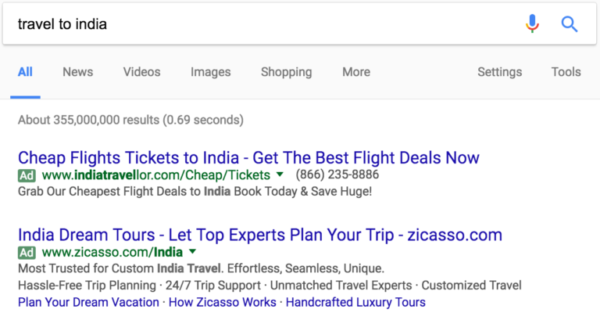Should you bother rewriting your ads?
Rewriting and testing your ad copy may not be the most glamorous way to improve your paid search campaigns, but columnist Jacob Baadsgaard points out that it can be an incredibly effective way to get more bang from your budget.
When it comes to paid search, there is a lot to optimize. Amidst all of the keywords, bidding and landing page refinements you have to do on a regular basis, it can be easy to wonder, “Does my ad copy actually make a difference?”
To make matters worse, there’s nothing exciting about tweaking ad copy. Redesigning a landing page is like creating a piece of art. Eliminating keywords can dramatically cut your cost-per-conversion. But ad copy? Does tweaking a word here or there really make a difference?
As it turns out, the answer is a resounding, “Yes!”
The fact of the matter is, you can have the best targeting and landing pages in the world, but if you’re showing the wrong ad copy to the right audience, no one is going to click on your ads. On the other hand, with the right ad copy, you can get more clicks and more of the right clicks on your ads.
Ad copy matters
We recently took on a new client who was getting decent results from their AdWords campaigns. Decent, but not great. By and large, they had most of the right elements in place… with one exception:
Ad copy.
Now, since everything else was set up right, they were about break-even with their campaigns. However, after taking a look at their ad copy, we knew they could do a lot better than simply “breaking even.”
So, we rebooted their ad copy. We overhauled everything — CTAs, title case, special characters and more — and ensured that their revised text ads were pointing to landing pages that closely matched the new messaging.
It was a fairly simple change, but the results were truly impressive:

In fact, the new ad copy performed so much better that it increased conversion rates (not just click-through rates) by 400 percent. And the cost-per-conversion fell from well over $2,000 to just under $60.
Not too shabby for a few hours’ work.
Now obviously, not every business will get these sorts of results from a few ad copy tweaks. But rewriting and testing your ad copy can be one of the most valuable paid search optimizations you can do.
Rewriting your ad copy
Knowing that rewriting ad copy is important and knowing how to effectively rewrite your ad copy are two entirely different things. Hopefully, I’ve convinced you that you should be rewriting your ad copy, but let’s take a look at how to approach an ad copy rewrite.
In essence, great text ad copy does three things:
1. It makes people feel something
People don’t buy for logical reasons. They buy for emotional reasons. In fact, 90 percent of the decision-making process happens subconsciously. So, if you want people to respond to your ads, your ads need to resonate with or evoke an emotion in your target audience.
The good news is, people search online and see your ads because they have a problem they need solved. Problems make us feel uncomfortable and uncertain, which are great emotions to play on.
For example, if you’ve got a sudden, unexpected international business trip and your passport has expired, you might type “renew passport” into Google:

At this point, you’ve got two problems: 1) you need your passport fast; and 2) you’re probably pretty busy getting ready for your trip, so you can’t really afford to spend hours in line at the passport office.
Is it any wonder that these ads address both of those problems?
“Traveling and Need to Renew Fast?” That’s you! “No Waiting in Line Or Red Tape.” Yep, you again!
Now, if your trip is next week, which ad do you think you’ll be most likely to click? If I had to guess, I’d bet you’d pick the second one. After all, you are in such a time crunch that you are probably pretty stressed about getting your passport back in time.
Ad #2 addresses your biggest problem directly in their copy (“Get Your Passport in as Little as 24 Hours”), so they are much more likely to get your click.
Do you see how this works?
If people resonate with your ad copy because it addresses their real problem, they’ll immediately feel a sense of relief and connection. That sense of relief and connection earns clicks. So, if you want people to click on your ads, write copy that speaks to the problem that prompted their original search.
2. It passes the logic gut-check
Now, while people buy because of emotion, most people know that purely emotional decisions are often bad decisions. In other words, they want to feel like they are making a logical, rational decision when they click, convert or buy.
But honestly, the rationale behind a decision is less important than how rational a person feels about their decision.
When it comes to ad copy, your audience’s need to feel like they are making sound, rational decisions means your ad copy needs to pass a “logic gut-check.” Typically, most people who are looking at your ad are looking for signs that clicking on your ad is a logical decision. They might not realize what they are doing, but they are essentially screening for fishy or misleading ad copy.
Fortunately, it’s fairly easy to pass this logic gut-check — provided that you know what your audience is screening for.
For example, say you’re running a business, and your CEO has decided that the company needs some project management software. She tasks you with finding a solution, so you search for “project management software” on Google:
 100vw, 546px” data-lazy-src=”https://searchengineland.com/wp-content/seloads/2017/02/project-management-software-546×400.png” /></p>
<p>Since your boss expects you to find a high-quality, reliable solution, you aren’t looking for an ad that “feels right.” You’re running a logic gut-check on each of these ads.</p>
<p>While price will probably be a factor in your long-term decision, odds are that what you are screening for on your initial search is a product with a proven track record that’s also easy to learn and use.</p>
<p>And look at that! Each of these ads addresses those points to one degree or another.</p>
<p><em>“Preferred by 1.5 million users.”</em> Sounds like a proven track record to me. <em>“Powerful and Very Easy-To-Use.”</em> Well, that hits the “easy to learn and use” concern on the head. <em>“7,000,000 people tried Smartsheet.”</em> Another great track record claim, it would seem.</p>
<p>Depending on exactly where your priorities lie, any of these ads might stand out to you, but assuming that track record and ease of use are your highest priorities, which ad do you think you’ll click on?</p>
<p>There’s a good chance you’ll pick ad #2.</p>
<p>After all, neither ad #1 nor ad #3 mention ease of use. Ad #2 mentions both ease of use <em>and</em> a proven track record (<em>“Powerful and Very Easy-To-Use”</em> in the headline and <em>“Proven over 15+ years of real-world use</em><em>” </em>in the subhead).</p>
<p>In fact, ad #3 says that <em>“7,000,000 people <strong>tried</strong> Smartsheet.”</em> But did they actually keep using it? Maybe it’s hard to use, so people try it and then give up. Otherwise, wouldn’t Smartsheet say that 7,000,000 <em>use</em> their product?</p>
<p>Uh-oh. Looks like ad #3 fails the logic gut-check.</p>
<p>Do you see how important it is to pass the logic gut-check? People won’t necessarily click just because you fit their screening criteria, but if your ad sets off logical alarms, your target audience is going to be a lot less likely to click on your ad.</p>
<h3>3. It catches their eye</h3>
<p>Now, it might seem a bit odd to call a text ad “eye-catching,” but if people don’t notice your ad, they certainly won’t click on it. Here again, your ad needs to get past another filter. But this time, it’s a filter called “<a href=) selective attention.”
selective attention.”
In a nutshell, selective attention is how our brains deal with all the chaos in the world around us. Instead of paying attention to everything all at once, the brain looks for things that are familiar or relevant to the task at hand and only pays attention to those things.
For example, remember that time when you purchased a new car and suddenly started seeing that make and model everywhere? That’s selective perception.
The same idea applies to ad copy.
When someone searches online, the keywords associated with their search become a high priority to the brain. The brain has to process an awful lot of search results on the page, so it uses selective attention to filter for truly relevant results.
If the brain sees one of the high-priority keywords it’s searching for, that search result is deemed to be relevant, and the brain pays attention to it. Otherwise, the brain ignores it and moves on.
Search engines like Google know how important selective perception is to their search engine result pages (SERPs). After all, they are in the business of delivering relevant results, so it’s in their best interest to make it as obvious as possible to your brain that your SERP is relevant to your query.
This is why Google bolds your keywords in the SERP:

Check out those keywords. It’s like Google is telling your brain, “Look at this relevant ad!”
Since Google doesn’t allow you to include eye-catching images or make your ad copy more eye-catching by using unusual punctuation or capitalization, selective attention is the only real way to make your ads stand out to your audience.
To take advantage of selective attention, your ad copy needs to include the keywords your potential customers are subconsciously screening for. This is one of the reasons why dynamic keyword insertion can improve click-through rates.
The better your ad copy matches what your audience is searching for, the more likely they are to read and click on your ad.
Summary
Rewriting and testing your ad copy may not be the most glamorous way to improve your paid search campaigns, but it can be an incredibly effective way to get more bang from your budget.
If you want to write ads that really shine, though, you have to think about your audience in detail.
What problem drove them to search online? What sort of logic gut-check are they running your ad through? What keywords are their brains scanning for? Once you’ve answered these questions, you’ll be well-equipped to write text ads that truly shine.




